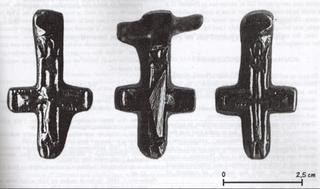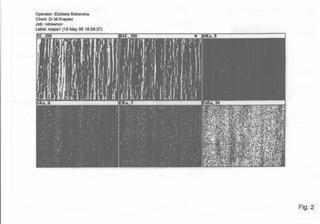The following text was extracted from the paper published on August 2004, by professor Andrzej Kotowiecki, during the 67th Annual Meeting of the Meteoritical Society, Rio de Janeiro, Brazil, under the original title "Artifacts in Polish collections made of Meteoritic Iron". The abstract is available online at http://meteoritics.org
Encolpion from Trepcza
A very interesting object, actually not made of meteoritic iron but of a (rare variation)  meteorite, is the 13th century Encolpion from Trepcza near Sanok. The discovery was thoroughly described by Jerzy Ginalski -the finder of this artifact and the directo of the Museum of Folk Building and the Ethnographic Park in Sanok.
meteorite, is the 13th century Encolpion from Trepcza near Sanok. The discovery was thoroughly described by Jerzy Ginalski -the finder of this artifact and the directo of the Museum of Folk Building and the Ethnographic Park in Sanok.
 meteorite, is the 13th century Encolpion from Trepcza near Sanok. The discovery was thoroughly described by Jerzy Ginalski -the finder of this artifact and the directo of the Museum of Folk Building and the Ethnographic Park in Sanok.
meteorite, is the 13th century Encolpion from Trepcza near Sanok. The discovery was thoroughly described by Jerzy Ginalski -the finder of this artifact and the directo of the Museum of Folk Building and the Ethnographic Park in Sanok.Encolpion with a relic is a unique reliquary, one of several encolpions found during salvage excavations in the Horodyszcze Castle in the years 1996-1997. As described by J. Ginalski, the encolpion is perfectly preserved, with straight bars in the shape of a cross, somewhat between a Latin and a Greek one, on its obverse there is a convex relief of the Crucifixion, while the reverse presents a concave relief of the cross. The tetragonally finished bars not widening at their ends differentiate the encolpion from the typical Kiev ones, which were very often finished with medallions embraced by two spherical knobs.
The reliquary is somewhat similar to some Palestinian encolpions (also known as Syrian-Palestinian) spread around the Mediterranean. Inside the bipartite reliquary from Trepcza was a tiny relic in the shape of a triangular wadge. It was placed along the vertical bars fo the cross, tightly matched to one of the edges -it was the only place to make it possible for the pectoral to close. Reliquaries usually adapted the form of the worshipped relic, therefore, the relic in question was interpreted to be a fragment of Christ's Cross. This hypothesis was also supported by the shape of the relic resembling a splinter as well as ist texture similar to this of wood.
Encolpion made of a metallic Meteorite with no Nickel
However, other features of the object, such as dark graphite color, metallic gloss, perfect smoothness of some parts, and most of all the weight too heavy for wood contradicted this theory. Thus, Dr. Marek Krapiec and Dr. Elzbieta Bielanska from Akademia Gorniczo-Hutnicza (AGH) in Kraków performed a detailed laboratory research of the preserved fragment using a scanning microscope at the Institute of Metallurgy of the Polish Academy of Sciences in Kraków. The analysis showed that the main element of the relic is Iron (90%), and chlorine, lead, arsenic, copper, calcium, aluminium, and silicon are its other components (see attached graphs below). Such high proportion of iron, togrther with absolutely no carbon, denies the possibility of dealing with the meteoritic or possibly indigenous iron. Therefore, further research was done with special emphasis on the presence of individual elements on the surface of the relic. It turned out that the ions of the admixtures are relatively regularly placed in the crystal structure of the iron. Taking into consideration the overall results of the analysis, Dr. Marek Krapiec suggested that the only plausible explanation for the origins of the analyzed fragment is attributing an extraterrestrial provenance to it. In his opinion, the relic placed in the encolpion from Trepcza is an extremely rare (as free from any traces of niquel) variation of iron meteorite!.
The author of the study J. Ginalski remarks that this is the only known case of using a piece of a meteorite as a relic and probably the encolpion was "tailored" for it only after its acquirement. This theory seems to be supported by the fact that the relic fits perfectly its casing and by the unique from of the Trepcza pectoral.
Conclusion
In my opinion, this object is very intriguing and woth spending more time studying it, especially, that the author of the study formulated a very BOLD THEORY concerning the lack of NICKEL in the specimen. Nevertheless, the problem is very exciting.
Posted by Andrzej Kotowiecki, District Prosecutor's Office, ul. Michejdy 17/4, 43-400 Cieszyn, Poland.
E-mail: tektites_andrew@poczta.onet.pl

